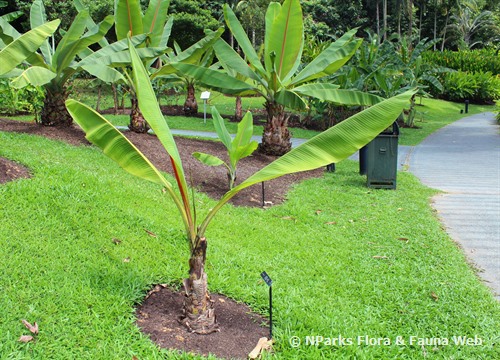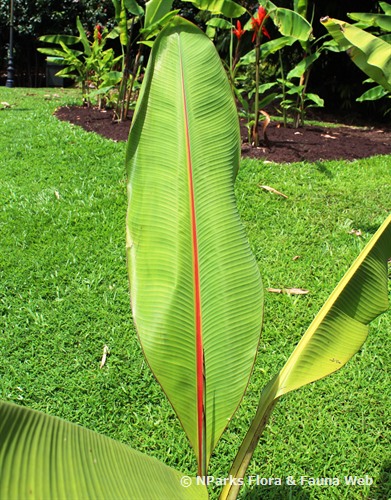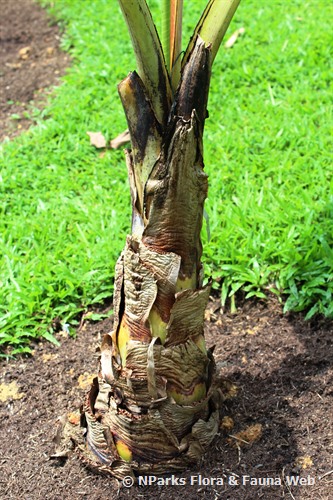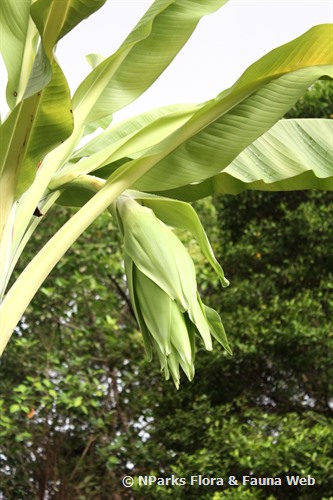
Back
Ensete ventricosum
| Family Name: | Musaceae |
| Common Name: | Ethiopian banana, Abyssinian banana, False Banana |
Name
Classifications and Characteristics
| Plant Division | Angiosperms (Flowering Seed Plants) (Monocotyledon) |
|---|---|
| Plant Growth Form | Herbaceous Plant |
| Lifespan (in Singapore) | Perennial |
| Mode of Nutrition | Autotrophic |
Biogeography
| Native Distribution | Tropical Africa |
|---|---|
| Native Habitat | Terrestrial |
| Preferred Climate Zone | Tropical |
Description and Ethnobotany
| Growth Form | An herb grows 6-12 m tall. |
|---|---|
| Foliage | Leaves are erect, paddle-shaped, growing up to 3-6 m long and 0.6-1.2 m wide, green with maroon midribs. |
| Stems | The pseudostem is made up of tightly-overlapping leaf sheaths. |
| Flowers | The hanging flower cluster emerges at the tip of the pseudostem. The non-showy flowers are white to cream-white, hidden under large maroon bracts. False banana is a monocarpic plant, which means it flowers only once in its entire life and then die completely. |
| Fruit | Fruits are 8-15 cm long and 4-5 cm wide, yellow to orange colored. |
| Habitat | Swamp margins, river banks, moist mountain forests. |
| Cultivation | The plants do well in nutrient-rich soils and in full sun. Need protection against strong wind, to prevent any damages to the large leaves. |
| Etymology | ventricosum means swelling, indicating the swollen pseudostem of this plant. |
| Ethnobotanical Uses | Edible Plant Parts : Edible Leaves, Edible Flowers, Edible Roots, Edible Storage Organs Food (Fruit or Vegetable): This plant is an important food crop in Ethiopia. The mashed leaf sheaths and underground stems can be fermented and made into a bread-like food. |
Landscaping Features
| Desirable Plant Features | Ornamental Flowers, Ornamental Foliage, Ornamental Form |
|---|---|
| Landscape Uses | Parks & Gardens |
Fauna, Pollination and Dispersal
| Seed or Spore Dispersal | Biotic (Fauna) (Vertebrates (Other Mammal)) |
|---|
Plant Care and Propagation
| Light Preference | Full Sun |
|---|---|
| Water Preference | Lots of Water, Moderate Water |
| Rootzone Tolerance | Well-Drained Soils |
| Diseases | Susceptible to anthracnose, wilt and mosaic virus. |
| Pest(s) | Chewing Insects, Sucking Insects |
| Propagation Method | Seed |
Foliar
| Foliage Retention | Evergreen |
|---|---|
| Mature Foliage Colour(s) | Green |
Non - Foliar and Storage
| Stem Type & Modification | Pseudostem |
|---|---|
| Root Type | Underground |
Floral (Angiosperm)
| Flower Colour(s) | Cream / Off-White |
|---|---|
| Flower Grouping | Cluster / Inflorescence |
| Flower Location | Terminal |
| Flowering Habit | Monocarpic |
| Flower Colour(s) Remarks | Bracts are maroon. |
Fruit, Seed and Spore
| Mature Fruit Colour(s) | Orange, Yellow / Golden |
|---|---|
| Fruit Type | Fleshy Fruit |
| Mature Seed Colour(s) | Black |
| Mature Seed Texture(s) | Smooth, Ridged / Corrugated |
| Seed Description | Seed shapes vary from nearly spherical to flattened and irregular, and from deeply grooved to almost smooth. |
| Seed Quantity Per Fruit | Numerous (>20) |
Image Repository
Others
| Master ID | 29781 |
|---|---|
| Species ID | 4090 |
| Flora Disclaimer | The information in this website has been compiled from reliable sources, such as reference works on medicinal plants. It is not a substitute for medical advice or treatment and NParks does not purport to provide any medical advice. Readers should always consult his/her physician before using or consuming a plant for medicinal purposes. |




